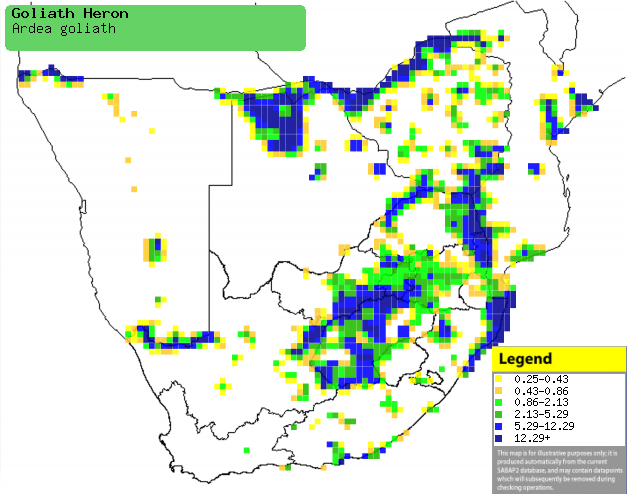Ardea goliath (Goliath heron)
Reusereier [Afrikaans]; Reuse-reier [Afrikaans];
uNozalizingwenyana [Zulu]; Ebo (also applied to Black-headed heron) [Kwangali];
Kokolofitoe -kholo [South Sotho]; Kôkôlôhutwê [Tswana]; Goliathreiger,
Reuzenreiger [Dutch]; Héron goliath [French]; Goliathreiher [German];
Garça-gigante [Portuguese]
Life
> Eukaryotes >
Opisthokonta
> Metazoa (animals) >
Bilateria >
Deuterostomia > Chordata >
Craniata > Vertebrata (vertebrates) > Gnathostomata (jawed
vertebrates) > Teleostomi (teleost fish) > Osteichthyes (bony fish) > Class:
Sarcopterygii (lobe-finned
fish) > Stegocephalia (terrestrial
vertebrates) > Tetrapoda
(four-legged vertebrates) > Reptiliomorpha > Amniota >
Reptilia (reptiles) >
Romeriida > Diapsida > Archosauromorpha > Archosauria >
Dinosauria
(dinosaurs) > Saurischia > Theropoda (bipedal predatory dinosaurs) >
Coelurosauria > Maniraptora > Aves
(birds) > Order: Ciconiiformes
> Family: Ardeidae
Distribution and habitat
Occurs across much of sub-Saharan Africa. In southern
Africa, it is uncommon to locally common in the
far south and north of Namibia (including the Caprivi Strip), northern and
eastern Botswana, Zimbabwe, central and southern Botswana and central and
north-eastern South Africa. It generally favours shallow water near the shore of
large water bodies, such as lakes, estuaries, mangroves, reefs and marshes.
|
 |
|
Distribution of Goliath heron in southern Africa,
based on statistical smoothing of the records from first SA Bird Atlas
Project (©
Animal Demography unit, University of
Cape Town; smoothing by Birgit Erni and Francesca Little). Colours range
from dark blue (most common) through to yellow (least common).
See here for the latest distribution
from the SABAP2. |
Movements and migrations
Resident and probably partially nomadic, as
birds have been recorded to move 100-290km.
Food
It mainly eats fish, doing most of its foraging among
floating vegetation in shallow water, walking extremely slowly (3-4 steps per
minute). When it spots prey it stops moving, coiling its neck before stabbing
the prey with its bill slightly open. Once caught it takes the food item to the
shore (like in the photo below), killing the animal before swallowing it
headfirst. The following food items have been recorded
in its diet:
- Vertebrates
- fish
- Acanthopagrus berda (Riverbream)
- Clarias gariepinus (Sharptooth catfish)
- Pomadasys commersonnii (Spotted grunter)
- Mugil cephalus (Flathead mullet)
- Muraenesox cinereus (Conger pike)
- Cyprinus carpio (Carp)
- Oreochromis mossambicus (Mozambique tilapia)
- Rhabdosargus holubi (Cape stumpnose)
- Rhabdosargus sarba (Natal stumpnose)
- Thryssa vitrirostris (Glassnose)
- eels
- birds (rarely)
- small mammals
- amphibians
- reptiles
- Invertebrates
Breeding
- Monogamous and usually a solitary nester, although it may breed in loose
colonies of 2-7 breeding pairs.
- The nest is built by both sexes, consisting of a large platform of
reeds, sticks and water plants, typically placed in a tall tree, on the
ground of an island, on a mat of trampled reeds or in flooded bushes or trees.
- Egg-laying season is year-round, peaking during the wet season.
- It lays 2-5 eggs, which are incubated by both sexes for about 24-30
days.
- The chicks are unafraid of humans: if disturbed, they make a hissing noise and sometimes
a
perform threat display. They leave the nest at roughly 40 days old,
becoming fully independent approximately 15 days later.
Threats
Not threatened.
References
-
Hockey PAR, Dean WRJ and Ryan PG 2005. Roberts
- Birds of southern Africa, VIIth ed. The Trustees of the John Voelcker
Bird Book Fund, Cape Town.
|
